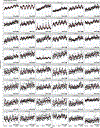Periodic Trends in Internet Searches for Ocular Symptoms in the US
- PMID: 36103713
- PMCID: PMC10474562
- DOI: 10.1080/09286586.2022.2119260
Periodic Trends in Internet Searches for Ocular Symptoms in the US
Abstract
Purpose: To identify periodic trends in internet searches for ocular symptoms and to determine the seasonal peaks and troughs.
Methods: This cross-sectional study examined publicly available Google Trends data from the United States (01/01/2015 to 12/31/2019). A list of common ocular symptoms was compiled from the American Academy of Ophthalmology Eye Health website and Wills Eye Manual. Ocular symptoms were stratified into categories involving vision change, eye pain, or eye redness. The search volume over time for each term was modeled using periodic regression functions and the goodness-of-fit was reported. Fisher's exact tests were used to compare the characteristics of periodic vs. non-periodic query terms.
Results: Seasonal trends were demonstrated by 45% (48/106) of the ocular symptoms included in this investigation. Search terms with best fit to the periodic model included stye (r2 = 0.89), pink eye (r2 = 0.82), dry eye (r2 = 0.76), blurry vision (r2 = 0.72), and swollen eye (r2 = 0.71). Periodic search terms were more likely to involve eye redness (21% vs. 11%, p = .014) and less likely to involve vision change (11% vs. 36%; p < .001). Periodic queries involving eye redness most often peaked in the spring and those involving eye pain peaked in the summer.
Conclusion: Ocular symptom queries directly reflect seasonal trends for allergic eye disease and ocular trauma. Search query analyses can serve as accurate epidemiological tools with research and real-world clinical applications.
Keywords: allergic eye disease; eye infection; google trends; infodemiology; ocular trauma.
Conflict of interest statement
Financial Disclosures: No authors have relevant financial disclosures.
Figures



References
-
- Seifter A, Schwarzwalder A, Geis K, Aucott J. The utility of “Google Trends” for epidemiological research: Lyme disease as an example. Geospatial Health 2010. May;4(2):135–7. - PubMed
-
- Carneiro HA, Mylonakis E. Google Trends: A Web-Based Tool for Real-Time Surveillance of Disease Outbreaks. Clin Infect Dis 2009. Nov 15;49(10):1557–64. - PubMed
Publication types
MeSH terms
Grants and funding
LinkOut - more resources
Full Text Sources
Other Literature Sources
Medical
